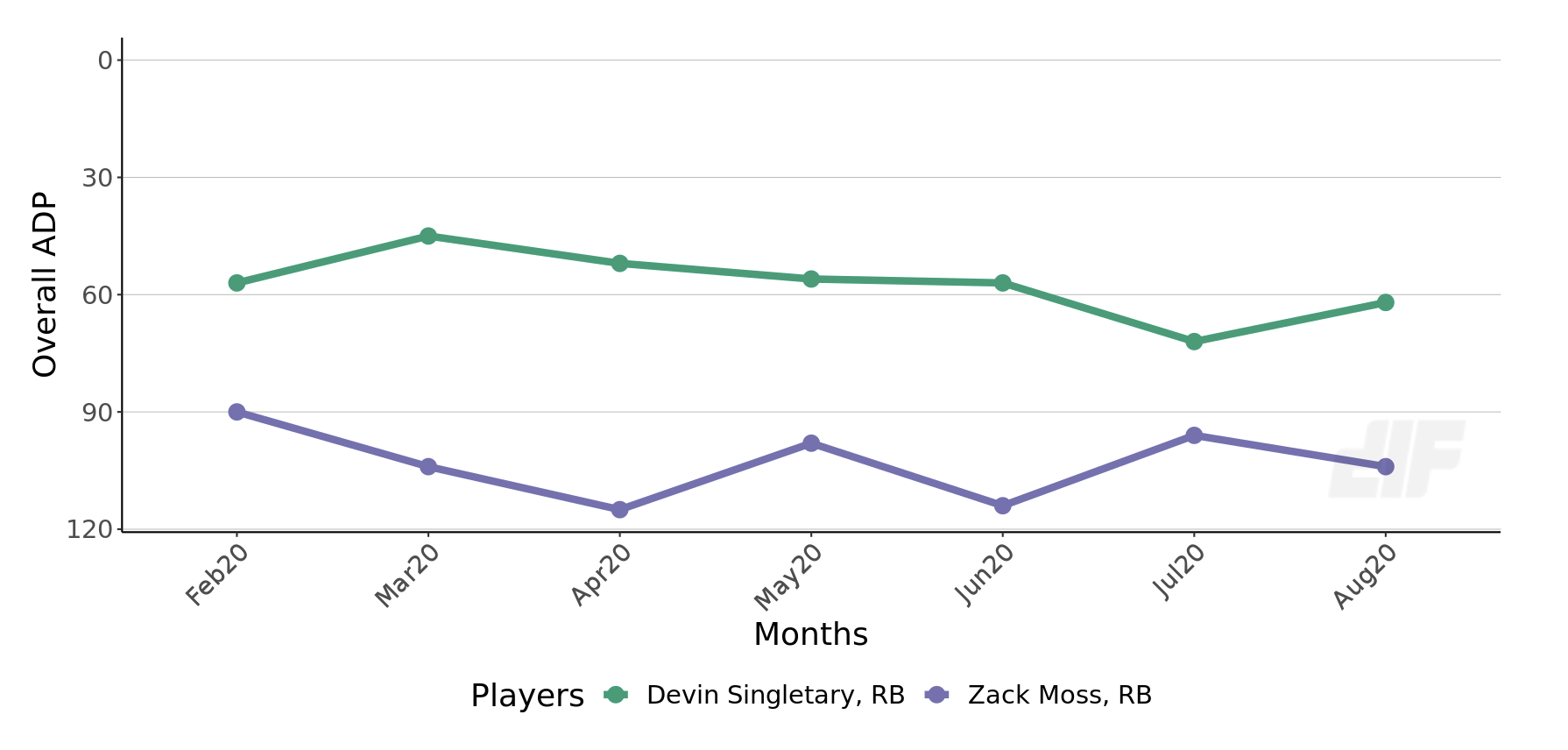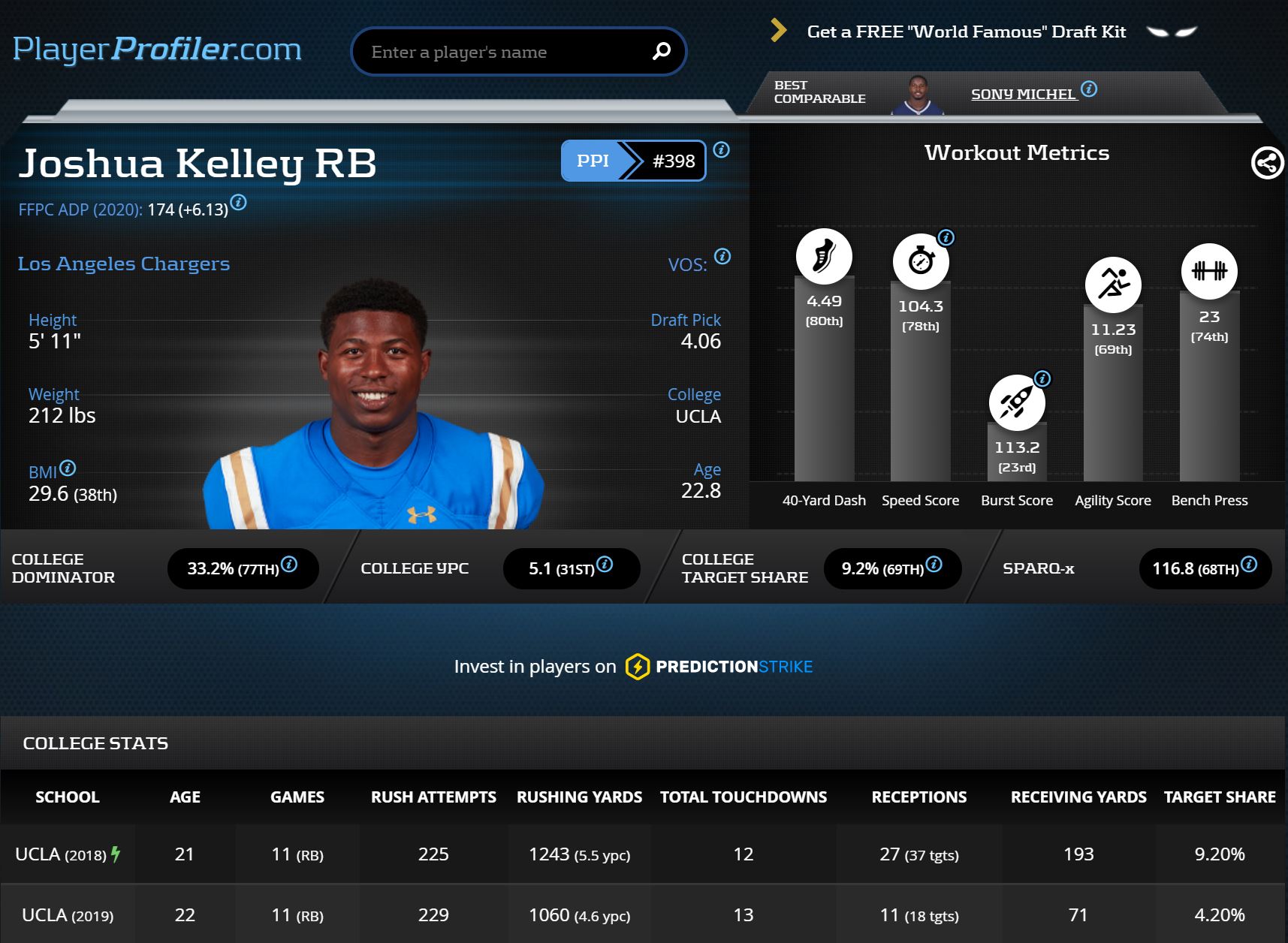Targeting ambiguous backfields in fantasy football comes with a caution. In 2019, eight teams entered the season with a different running back than they ended with. San Francisco, Tampa, and New England took the hot hand approach with three RBs cresting 250-plus snaps. Philadelphia started the 2019 season splitting snaps between Miles Sanders and Jordan Howard before Howard was injured in Week 9 and Sanders took over. In 2020, upwards of 10 teams look to deploy ambiguous backfields. We can use PlayerProfiler’s advanced stats, metrics, and analytics to find out who this season’s 49ers, Buccaneers, and Patriots will be and how to play these backfields in fantasy.
Buffalo Bills
Having spent back-to-back early-round draft picks on running back for the first time since 1986, 1987, and 1988 when they took Ronnie Harmon, Jamie Mueller, and Thurman Thomas, it’s clear what offensive coordinator Brian Daboll’s intention is in 2020. Run. The. Ball. In Daboll’s first two seasons, Buffalo finished with 465 and 468 team rushing attempts. This year will be no different with rookie Zack Moss and his 32.9 (93rd-percentile among qualified running backs) BMI inheriting the Frank Gore lead back role, with second-year man Devin Singletary as the change-of-pace and receiving back. Singletary’s 86.1 (15th-percentile) Speed Score was the lowest of any running back with 400-plus rushing yards in 2019.
In 2019, Singletary finished as the RB28 on a Fantasy Points per Game-basis per PlayerProfiler, while Gore finished as RB57. With Singletary being picked at RB27 per FFPC ADP, and Moss being picked at RB34, both can fulfill their ADPs while also being extremely volatile each week. With Josh Allen at the helm, and most likely to lead the team in rushing touchdowns, the Moss-Singletary duo will be a fade in PPR season-long formats.
Los Angeles Rams
The Rams finished with 400 rushing attempts in 2019, down 12-percent from Sean McVay’s first two seasons. After missing the playoffs, the Rams looked to revamp their offense by releasing Todd Gurley and trading Brandin Cooks. The moves cleared up $18 million in cap space, allowing them to draft Cam Akers and Van Jefferson. If they hope to return to the playoffs in 2020, Akers and his 108.7 (89th-percentile) Speed Score will be a key piece in the puzzle. Akers brings an explosive skillset comparable to Dalvin Cook, the man he replaced at Florida State.
Through four weeks of training camp, Darrell Henderson has generated the most buzz, though lately it’s not for the good. Henderson suffered a soft tissue injury on August 22nd and has been on the shelf since. Coach McVay referenced his “grasp for the offense and self-ownership” when talking to reporters about him playing in the season opener without practice. Malcolm Brown got the start in Saturday’s team scrimmage and is the logical starter for the Week 1 opener against Dallas. Akers took over in the second series and scored on a 5-yard run, receiving the bulk of carries during the scrimmage. Third-year back John Kelly, listed fourth on the depth chart, also scored a touchdown with the first team.
https://www.youtube.com/watch?v=opf7wwLUmAk
While Cam Akers, the current RB22 per FFPC ADP data, holds top 10 upside in 2020 and beyond, the veteran starter in Brown goes undrafted in most formats. If Henderson, the current RB47, stays healthy, the three-headed monster in LA could be a pain for fantasy games all season long. If Akers takes the reigns early, he has the highest upside and has league-winner written all over him.
Los Angeles Chargers
The Los Angeles Chargers lost eight one-possession games in 2019, a season after making the playoffs with a 12-4 record. With Philip Rivers and Melvin Gordon‘s departures in free agency, the Chargers look to lean on efficiency and a strong running game led by Tyrod Taylor and Austin Ekeler. Ekeler burst on the scene in 2019 with 92 (No. 2) receptions, and 993 (No. 2) receiving yards on an 85.2-percent (No. 5) Catch Rate while splitting touches with Gordon.
Rookie Joshua Kelley opened up training camp behind Justin Jackson, but he earned more opportunities each week according to Chargers beat writers. Pairing Kelley’s 104.3 (78th-percentile) Speed Score with back-to-back 240-touch seasons in college provides a perfect fit as the thunder to Ekeler’s lightning. In 2019, Gordon and Ekeler both finished inside the top 14 in Fantasy Points per Game with the team only running the ball 38-percent of the time.
With a top 5 defense, the Chargers will look to slow down games with an efficient and dominant running game centered around their three-headed monster. While Ekeler is drafted in the second round, both Jackson and Kelley are great values in the 15th round or later. Pairing Ekeler with Kelley or Jackson gives us another strong, safe backfield we can have at value, with Ekeler carrying overall fantasy RB1 upside in the late-second round.
Baltimore Ravens
Over the past five years, it’s hasn’t been uncommon to see a team throw the ball 60-percent of the time. In 2019, 21 teams passed over 57-percent of the time, while only one team rushed over 57-percent of the time. That team was the Baltimore Ravens. The winning formula was led by phenom Lamar Jackson, whose 1,206 rushing yards were the most ever by a quarterback. Jackson and veteran Mark Ingram, who finished No. 1 in Juke Rate among qualified running backs, led the vaunted Ravens rushing attack to over 2,200 yards. Second-year UDFA Gus Edwards put up over 700 yards on the ground for the second straight season, though he only averaged 5.8 (No. 60) Fantasy Points per Game due to only scoring two (No. 61) touchdowns.
Check out Mark Ingram’s 2020 Projection on PlayerProfiler’s “World Famous” Draft Kit:
The odd man out again looks to be second-year speedster Justice Hill, who brings a different dynamic than the other backs with a 133.0 (95th-percentile) Burst Score. Hill finished 2019 with only 295 yards on 66 touches. After picking J.K. Dobbins in the second round of April’s NFL Draft, Hill seems to be seated at the edge of the depth chart. With training camp wrapping up, coach Harbaugh said Dobbins’ confidence, coachability, and talent is a great combination, and that Dobbins will probably have a significant role in 2020.
https://www.youtube.com/watch?v=y082sS1iCuc
The dynamic trio of Jackson, Ingram, and Dobbins can all be had, but at a steep price, with all three going inside the first six rounds per FFPC ADP data. Spending early-round capital on multiple backs in the same backfield is less than ideal in fantasy football. Though if you can hedge the Ravens backfield by pairing Jackson in Round 2 with both Ingram AND Dobbins in the mid-rounds, it will give you an upper hand on the competition.
Conclusion
Fading the Buffalo Bills backfield when they are taking a page out of Baltimore’s Konami Code playbook will be a tough task. Though when compared to 2019’s ambiguous backfields, they show visions of the San Francisco 49ers. Complete with T.J. Yeldon and Taiwan Jones deep on the bench, carrying above-average athleticism and football IQ, playing the roles of Raheem Mostert and Jeff Wilson.
The Los Angeles Chargers backfield is the buy of the offseason, with Austin Ekeler carrying a late-second round ADP, and with both Joshua Kelley and Justin Jackson going late in drafts. Hedging has never been easier than with the Chargers in 2020. If you’re drafting this weekend, be sure to pair Ekeler in Round 2 with your Round 1 workhorse while targeting Kelley late.





